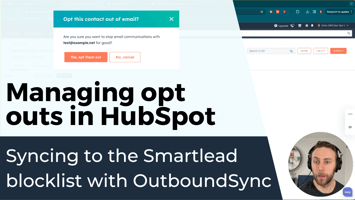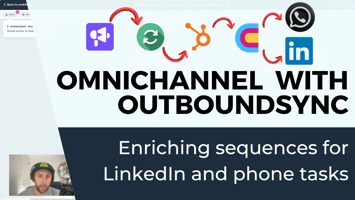You can use OutboundSync's new cold email blocklist to block all of your opt outs from HubSpot....
Text to Content: ChatGPT makes flowcharts and 3D models
Our team has been diving into some exciting GPT applications that are not just cool but could also shake up your outbound strategies. There are two applications of a broader concept which is going from text to content.
First, creating flowcharts with ChatGPT. For this, we'll use Mermaid. It's an open source program that transforms text-based prompts into visual flowcharts.
Next, a wild one. Creating 3D models using a program called OpenSCAD. It creates parametric models using a programming language rather than the user interface (UI).
These applications of ChatGPT are just scratching the surface. They demonstrate how we can use AI to generate content for tools without prior knowledge. Check out the video or transcript (below) to learn more.
Transcript
Introduction
[00:00:00] Harris Kenny: Hey, it's Friday. I was working on some fun things. You can see a lot of stuff on the screen here. I'm going to explain what's going on, but I just wanted to explain to fun GPT concepts or applications that you could potentially use in outbound to get someone's attention, bit of a pattern interrupt, or you might just find personally useful. And the underlying concept that's driving both of these applications.
[00:00:23] Harris Kenny: So there are programs. That require you to use the interface to make things. So 3d modeling software or flow chart creation.
[00:00:32] Harris Kenny: And then there are other programs that allow you to use code or programming language that you write out, and then it's rendered, and that thing shows up on the screen for you.
[00:00:43] Harris Kenny: In this example today, I'm going to show you two examples, a flowchart, and a 3d model that I created using ChatGPT, text-based prompts.
[00:00:52] Harris Kenny: And I will say, like, I've done actually useful things with both of these, but I'm just going to show you a couple of examples here for fun. Let me make myself smaller with myself out of the way and explain what we're doing here.
Making flow charts with ChatGPT and Mermaid
[00:01:04] Harris Kenny: So first uh, I've got prompt here. That's using mermaid. Mermaids an opensource program. Uh, if you go to mermaid.live, you can get a live editor previewer. And so you go into chat GBT, and you explain what you want to show. Through your flow chart. And I just made up an app that does something to social media and e-commerce stores.
[00:01:24] Harris Kenny: And then what to do is it's going to create that.
[00:01:27] Harris Kenny: And so I've got that example, flowchart here. And you can see the code that chat GBT generated. I put right inside. And you can change it. And adapt it and change the colors. Change the font, change the text. I've used this to create some really useful flowcharts for OutboundSync, which is a product that we've built.
[00:01:45] Harris Kenny: What I found is that I started to kind of figure out that how the language works on my own and I can push it further, go through their documentation, their forums, and then you can kind of learn by doing in this way. So that's pretty cool.
Making 3D models with ChatGPT and OpenSCAD
[00:01:56] Harris Kenny: Let me just jump into the other one, which is that I've got some ideas for projects that I'd like to do with my daughter. So we've got, she's getting really into board games right now and playing in general. And so I thought it'd be really fun to potentially get her into a 3d printing, which I had done for a number of years.
[00:02:11] Harris Kenny: And there's a program called open SCAD or open S CAD. That allows you to create parametric models using this programming language. Uh, so this is also an open source project, open scad.org, you can download the program and with ChatGPT here I'm explaining a model that I want it to create for me.
[00:02:31] Harris Kenny: And then it generates this code and then you can copy and paste this code into. OpenSCAD.
[00:02:37] Harris Kenny: And so now this is the exact code that GPT put together. And then you can modify it, change it. And again, you can kind of learn. Now this would be the plane of the 3d printer. I think that this may or may not be printable. I think it's probably not the best model to start with. Obviously. But I think it's a really interesting idea.
Conclusion
[00:02:54] Harris Kenny: And if you can use chat GPT, then you can generate content for those tools without knowing anything about them. I think there are some really powerful potential applications here, and I've just honestly been having fun with this and figured I would share it. Cool use of GPT and potentially has prospecting applications, but also, maybe it's just fun for a-- for weekend projects.
[00:03:14] Harris Kenny: Who knows where it'll go from here. All right. Let me know what you think. Let me know if you make anything. Thanks.


